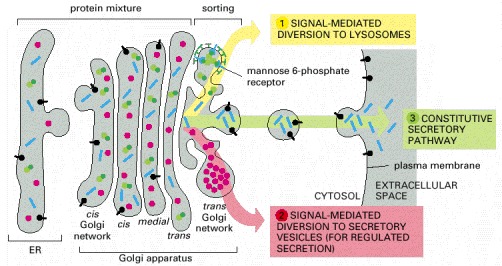From: Transport from the Trans Golgi Network to the Cell Exterior: Exocytosis

NCBI Bookshelf. A service of the National Library of Medicine, National Institutes of Health.

(1) Proteins with the mannose 6-phosphate (M6P) marker are diverted to lysosomes (via late endosomes) in clathrin-coated transport vesicles (see Figure 13-37). (2) Proteins with signals directing them to secretory vesicles are concentrated in such vesicles as part of a regulated secretory pathway that is present only in specialized secretory cells. (3) In unpolarized cells, proteins with no special features are delivered to the cell surface by a constitutive secretory pathway. In polarized cells, however, secreted and plasma membrane proteins are selectively directed to either the apical or the basolateral plasma membrane domain, so that at least one of these two pathways must be mediated by a specific signal, as we discuss later.
From: Transport from the Trans Golgi Network to the Cell Exterior: Exocytosis

NCBI Bookshelf. A service of the National Library of Medicine, National Institutes of Health.